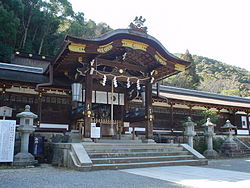- Matsunoo-taisha
-
Matsunoo-taisha
松尾大社
The haiden, at Matsunoo-taisha Information Dedicated to Ō-yamagui-no-kami
Nakatsu-shima-hime-no-mikoto
TsukuyomiFounded 701 Address 3 Arashiyamamiya-chō, Nishikyō-ku, Kyōto-shi, Kyōto-ken
〒 616-0024Phone 075-871-5016 Website Homepage Matsunoo-taisha (松尾大社 "Matsunoo Grand Shrine", formerly Matsunoo-jinja 松尾神社) is a Shinto shrine located at the far western end of Shijo Street, approximately 1.3 kilometers south of the Arashiyama district of Kyoto, Japan. It is home to a spring at the base of the mountain, Arashiyama, that is believed to be blessed.
It is said that during the move of the capital from Nagaoka to Kyoto, a noble saw a turtle bathing in under the spring's waterfall and created a shrine there. It is one of the oldest shrines in the Kyoto area, its founding extending back to 700 AD. The restorative properties of the spring bring many local sake and miso companies to the shrine for prayers that their product will be blessed.
The shrine also serves a kinpaku (gold leaf filled) miki (or blessed sake) during hatsumode.
Contents
History
The shrine became the object of Imperial patronage during the early Heian period.[1] In 965, Emperor Murakami ordered that Imperial messengers were sent to report important events to the guardian kami of Japan. These heihaku were initially presented to 16 shrines including the Matsunoo Shrine.[2]
From 1871 through 1946, Matsunoo-taisha was officially designated one of the Kanpei-taisha (官幣大社), meaning that it stood in the first rank of government supported shrines.[3]
Images
See also
Notes
- ^ Breen, John et al. (2000). Shinto in History: Ways of the Kami, pp. 74-75.
- ^ Ponsonby-Fane, Richard. (1962). Studies in Shinto and Shrines, pp. 116-117.
- ^ Ponsonby-Fane, Richard. (1959). The Imperial House of Japan, pp. 124.
References
- Breen, John and Mark Teeuwen. (2000). Shinto in History: Ways of the Kami. Honolulu: University of Hawaii Press. 10-ISBN 0-824-82363-X; 13-ISBN 978-0-8248-2363-4
- Ponsonby-Fane, Richard. (1962). Studies in Shinto and Shrines. Kyoto: Ponsonby Memorial Society. OCLC 399449
- ____________. (1959). The Imperial House of Japan. Kyoto: Ponsonby Memorial Society. OCLC 194887
External links
- Official Site (English)
- Official Site (Japanese)
Coordinates: 35°00′01″N 135°41′07″E / 35.00028°N 135.68528°E
Shinto shrine Shinto architecture Buildings - chōzuya or temizuya
- haiden
- heiden
- hokora
- honden / shinden / shōden
- kagura-den
- massha
- sessha
Architectonic elements Styles - hirairi-zukuri
- tsumairi-zukuri
- gongen-zukuri
- hachiman-zukuri
- hiyoshi-zukuri
- irimoya-zukuri
- ishi-no-ma-zukuri
- kasuga-zukuri
- kibitsu-zukuri
- misedana-zukuri
- nagare-zukuri
- ōtori-zukuri
- owari-zukuri
- ryōnagare-zukuri
- shinmei-zukuri
- sumiyoshi-zukuri
- taisha-zukuri
Others Implements Main kami Staff Head shrines1 - Fushimi Inari Taisha
- Usa Hachiman-gū
- Ise Grand Shrine
- Dazaifu Tenman-gū
- Munakata Taisha
- Suwa Taisha
- Hiyoshi Taisha
- Kumano Nachi Taisha
- Tsushima Shrine
- Yasaka Shrine
Miscellaneous 1 (in order of the size of the shrine network they head)
Categories:- 700s architecture
- Kyoto
- Shinto shrines in Kyoto Prefecture
- Shinto stubs
Wikimedia Foundation. 2010.



